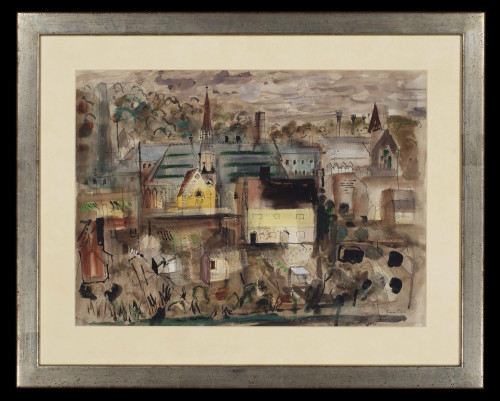Landscape with Rocks, 1944
10904
GRAHAM SUTHERLAND, O.M. (BritIsh,1903-1980)
Landscape with Rocks
Watercolour, gouache, ink, pastel and chalk
Executed in 1944.
PROVENANCE : The Artist. Redfern Gallery, London, label verso. Acquired by the late-Maurice Cook, 19th December 1952.
EXHIBITED :
Graham Sutherland Drawings of Wales, an exhibition arranged by the Welsh Committee of the Arts Council, 10th June - 26th October, 1963, cat. no.47.
RELATED TO :.
Excavators Uncovering Coal Seam Pwll-du, 1943, Leeds Museums & Galleries, No 63 Graham Sutherland (Hammer).
Outcast coal production 1943 No 47c (Sutherland DC).
Folded Hills, 1943, No 68 Graham Sutherland (Hammer)
Rock on an estuary shore No 40, Turin Exhibition 1965
Triple tiered landscape, No 55 Graham Sutherland (Cooper)
Open Cast Coal Production, NMW A 3265
Limestone Quarry (Sheltering Whilst Blasting)' (1943). NMW A 3267
Landscape with Pointed Rocks, 1944, Derek Williams collection NMWA (L) 621
Sheet height 39 cm., 15 ½ in,. Length 32.5cm.,12 ¾ in..
In a black, and gilded, Tuscan cassetta frame
Frame Height 63 cm, 25 in., Length 56 cm., 23 in.
' With Sutherland the line is seismographic, tentative, seeking its way in planes of strong colour, contrasting sometimes with black areas, often undecided in its attempt to translate from naturalistic shapes to artistic forms ' (The dilema of being modern essays on art and literature J P Hodin)
Landscape with Rocks is a significant, picture containing new stylistic features which GS was to make more elaborate use of in his later, nature paintings. It forms a link between the critical phases of his artistic development which occupied a period of about four years (1944-8) and affected every aspect of his work; subject, colour, composition and handling.
Landscape with Rocks is derived from the work that GS produced for the War Artists Advisory Committee, inspired by a series produced at an opencast coal mine in Pwll-du near Abergavenny during July/August 1943. In 1944, GS re-visited this subject to conclude the experience and 'pin down its essence'. As it is one of his independent works, he expresses full stylistic freedom in dissecting and formally reconstructing the elements to elaborate his original visual experience. Whilst many of the same motifs recur, new ideas start to appear. He gives up receding perpectives and brings the natural forms closer to the eye and to the surface of the canvas. He begins to pile planes one above the other rising up the canvas. The landscape surges upwards in stages, as the foreground of the open cast mine is seen at ground level, and the artificial, mounds and natural hills appear to be standing on a platform above. This device will appear constantly from now on and in this work the levels feel integrated although GS goes on to use the platform to isolate natural specimens from organic context.
As the element of pictorial space has become shallower, GS focuses on detail and develops groupings of small forms at the face of the mine and in the hills. This is accompanied by a significant change in palette. He said that colour suddenly became important to him, and that he discovered that he could use it 'emotively' and arbitrarily'. In this work, GS is starting to reveal himself as a vivid colourist with an original and personal sense of harmonies. He banishes the dark and heavy tones which he had used earlier, though he preserves the sharp black and white oppositions and uses to acid pinks and mauves, light blue and orange, scarlet, emerald and chrome yellow.
This work preceeds a series of drawings and gouaches known as Landscape with Pointed Rocks which resulted from a trip to Pembrokeshire in the summer of 1944 which GS made with Kathleen, John Craxton and Lucien Freud.
Landscape with Pointed Rocks, 1944, from the Derek Williams Collection held by National Museum of Wales (NMW A (L) 621 has striking visual similarities with Landscape with Rocks. Both are a testament to how integrated and reciprocally inspirational GS's war work and his wider, particularly Welsh Landscape, practice had become by this date.
'After I had been to Wales I began to notice in landscape that almost everything, if one keeps one's eyes open, is potential material for painting; and, more than that, certain elements of nature seem to me to have a kind of presence…shadows had a presence; certain conformation of rock seemed to go beyond being a rock, they were some kind of personality.' 1934 Sutherland
20th Century
1944
British
Redfern Gallery, London. Acquired by the late-Maurice Cook, 19th December 1952.
























